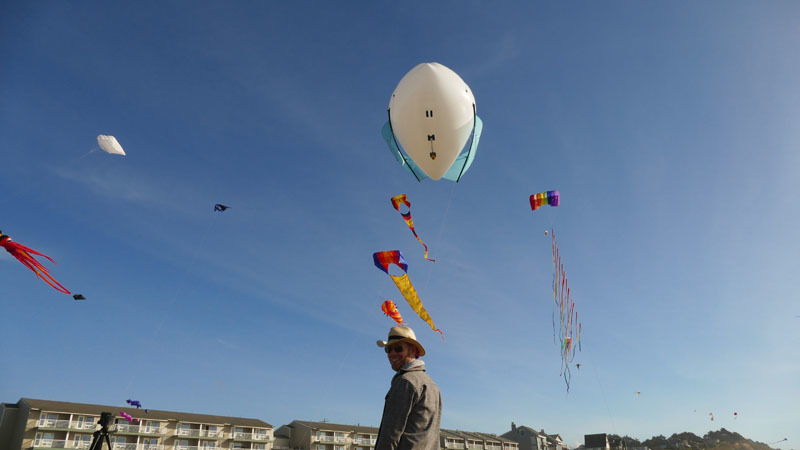Overview
Airpup is a small kite balloon designed for quiet, long-duration flight in most weather without the restrictions placed on drones. You can read more about Airpup on my blog, get Airpup on Crowd Supply, and download Airpup's assembly patterns on github.
Airpup is stable and maneuverable. At 37 cubic feet of helium, Airpup takes about 60% of the gas needed to fly a Balloon Mapping Kit. Payloads up to 500g fly in winds from 0mph to surpassing 20mph.
I've been enjoying taking aerial video using a phone gimbal.
Airpup navigating the air between kites at the Lincoln City Fall Kite Festival:
You can download the patterns for Airpup on Github. All 2D plans are made with open source QCAD. 3D models are made with Autodesk's Fusion 360.
Design goals
Airpup's design grew out of the ways people have used balloon and kite mapping, and the issues they faced moving helium tanks, moving inflated balloons and long kites, and flying on their own schedule-- not the wind's.
I wanted to combine the reliability and simplicity of a balloon with the ability to fly in higher winds like a kite. I also wanted to make payload attachment simple, so there are few strings to get tangled and no stabilizers to set up.
I built rails into the belly that accept a standard 1/4-20 tripod mount, based on @ranon's rail mounts.

Kestrel 5500 weather station, Feiyu SPG gimbal & phone, Canon camera is mounted on an Aerobee Bracket
Although the resulting balloon is more expensive than a rubber balloon-based kit, Airpup packs down small and can be borrowed by mail.

Field testing
I walked the balloon and tank 4 miles round trip to the beach. At 25lbs, it was manageable in daypack with a hip band.

Using a Kestrel 5500 from my Aeropod, I recorded the winds in 30 second averages and overlaid them on the video.
To simulate higher wind speeds, I do tow tests by bike:
Winder
Airpup will come with a flat winder. The winder's figure-eight winding doesn't cause line twisting. Its narrow profile fits in a mailing tube.

Line can be tossed off of the winder for smooth line control.

More on how to use the winder on my blog. Plans are on Github.
Previously in kite balloons
This project has been on my mind for a while. A kite balloon featured in the first real-world conversation I had with @warren and my first time e-mailing with @danbeavers. A DIY kite balloon was the first thing I flew with @gonzoearth and @olivia, and the wiki page for a Kite-Balloon Hybrid was the first thing I posted to Publiclaboratory.org in January 2011, trying to collect @warren, @liz, @eymund's experimental designs with some sources I'd collected.

Flying a kite balloon with Stewart Long and Olivia Everett, March 2011. It flew alright but leaked helium over 20 minutes and got stuck in a tree
The project didn't go very far because we couldn't seem to make a small, lightweight balloon that both held helium and held up in the force of the wind. Our DIY mylar balloons were taped together and all leaked. The heat-seamed plastics I was working with couldn't hold pressure. A double envelope on top of a rubber balloon was over-weight. Party balloons weren't big enough to be kites and hold a camera. The manufacturer we worked with at the time, the now-defunct Southern Balloon Works only had 4 mil polyurethane that was too thick and heavy to make anything small. The idea of a Helikite-like balloon, as @warren and I talked about, was still under patent.
Some hints have been posted of functional DIY designs, such as @Alex_the_Ukranian's carbon-fiber framed polyethylene balloon.
Prototypes:
Concepts:
- @Valerie Balloon Kite design and prototype
- @Eustatic Sketches for "Corset-Chiton" idea for Pufferfish mod
- Making a balloon making jig

9 Comments
This Airpup is so awesome -- and cute, too! So exciting to see this becoming reality! I really appreciate reading through the history of idea development, and especially appreciate the gif of you unwinding line. An instant classic!
Reply to this comment...
Log in to comment
Mathew,
The Airpup can lift a payload of 500 grams when there is no wind. Will it lift more when there is wind? How hard was it pulling in the 20 mph winds?
Is this a question? Click here to post it to the Questions page.
Reply to this comment...
Log in to comment
@cfastie Yes, Airpup's lift increases with the wind. I didn't measure the pull in 20mph winds, but I can say that it was at the limit of my ability to haul in line. I would estimate around 30lbs of pull.
Airpup is a kite and will fly in a sufficient wind when heavier than air. I tried one flight with an envelope full of mostly air and about 10 cubic feet of helium, and that worked alright.
Airpup starts at 540g, growing to 1700g when inflated with air alone. In sufficient wind you could fly a brick too.
Reply to this comment...
Log in to comment
I should clarify that air adds mass not weight-- but a massive balloon is sluggish.
Reply to this comment...
Log in to comment
That sounds like a lot of lift in a good wind. Does that come mostly from the kite part or from the aerofoil shape of the balloon part?
Wait, doesn't air add weight, too? But it would register as weight (e.g., on a scale) only when it is in a medium lighter than air. A balloon full of water has weight, but it does not register as weight when it is under water. So it is "weightless" under water? I think I get it.
Is this a question? Click here to post it to the Questions page.
Reply to this comment...
Log in to comment
As a system, the balloon and kite parts are definitely lifting more than dragging-- Airpup climbs to higher angles as the wind goes from 3 to12mph and the pull is fairly light, much less than I would expect from a spherical balloon of a similar size.
From those winds on up the pull starts to really take off. I'm not sure which part is pulling the most.
One of the goals of the keels is to direct air into the low-pressure zone behind the balloon and increase air attachment on the back side. This is highly speculative though-- I have no proof this is what's happening, and need to do string and flow tests to verify.
Reply to this comment...
Log in to comment
In wwii, they had a kytoon ( a mixture kite and balloon for lifting emergency antennas)for downed airman. They show up now and then in the sur plus area. They came with chemical hydrogen generators, which are usually dead.
The design you have looks better. Congrats!
Reply to this comment...
Log in to comment
@Ag8n Yes, the Jalbert Kytoons! I covered them and a few other historical kite balloons here: https://www.headfullofair.com/post/what-is-a-kite-balloon/
Reply to this comment...
Log in to comment
uuugggghhhh, can't wait!!!!!!
Reply to this comment...
Log in to comment
Login to comment.